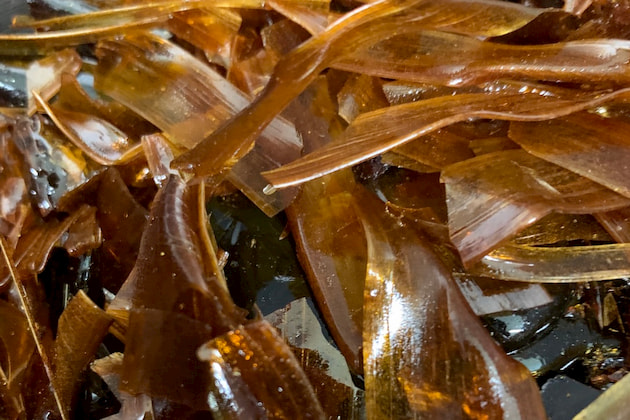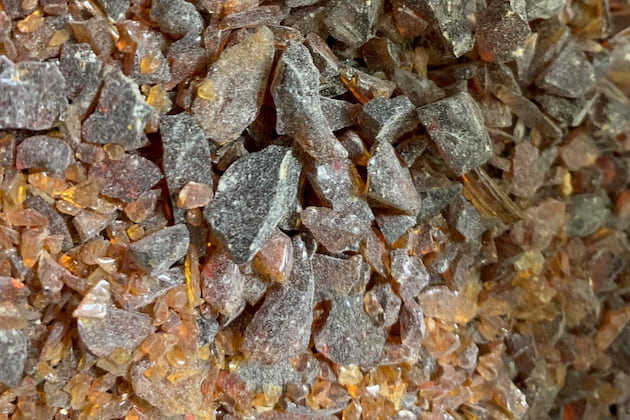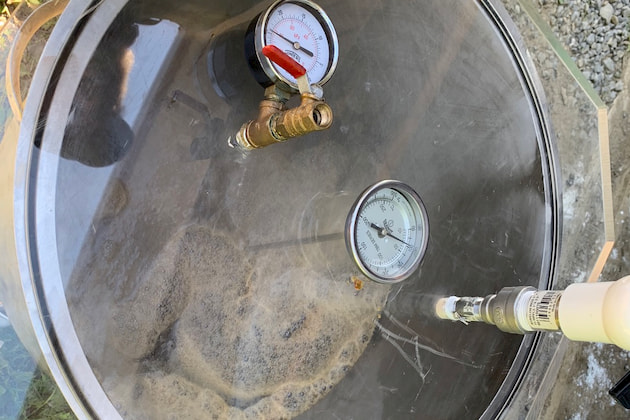Cornell Corner
Making sugar in a vacuum
Cornell researchers develop new method of making new kinds of maple sugar
By AARON WIGHTMAN | DECEMBER 15, 2020
VAN ETTEN, N.Y.—Who knew?
Vacuum is not only essential in extracting sap but can be used to make flavorful sugar.
Maple sugar has many applications and untapped potential in the marketplace.
To increase use of this wonderful product the Cornell Maple Program is experimenting with alternative sugar production methods. Some of these methods increase flavor and result in sugar with different properties suitable for a wide range of new uses.
In a previous article we described a process to make intense flavored maple sugar from high invert dark syrup by carefully cooking it to 305 degrees F, then cooling it to form an “amorphous solid” or hard candy. This solid can then be ground into a sugar and sifted into different size classes.
Two drawbacks of this approach are the possibilities of scorching or creating flavors that are too intense for some applications because of the high finish temperature.
Vacuum cooking is an alternative approach that creates strong flavor sugar from very dark syrup while avoiding these pitfalls. Vacuum cooking works because liquids boil at lower temperatures in a vacuum.
Think of it this way: atmospheric pressure is like a heavy blanket on top of your syrup. In order to boil away water, each water molecule needs enough heat energy to fight its way through the blanket.
In a vacuum, the weight of the atmospheric blanket is reduced so water molecules need less energy to escape the syrup.
The chart accompanying this article illustrates the reduction in boiling temperature at various levels of vacuum.
As you can see, the boiling point at 24 inches of vacuum is 140 degrees F. Without vacuum our target finishing temperature for amorphous sugar was 305 degrees F which is 93 degrees above the boiling point of water.
When we go 93 degrees above the boiling point of water under 24 inches of vacuum the finishing temperature is adjusted to 233 degrees F. This temperature is well below the scorch point and also induces a lesser degree of caramelization.
In order to process syrup in this manner, several pieces of equipment are required.
First, a heat resistant vacuum vessel is needed. In our experiments we used a specialized steel chamber that resembles a heavy pot with a thick acrylic cover. The lid must be fitted with a vacuum inlet, vacuum gauge, temperature gauge and a valved release vent.
Next, you will need a vacuum supply with a moisture trap that collects and condenses steam so it does not damage the vacuum pump.
We simply connected a supply line to the releaser of our sap collection vacuum. Lastly, you need a controllable heat source. In our study we used a small propane burner designed for use with a finishing pan.
Once the equipment is assembled, cooking the syrup is straightforward. The temperature should be kept just high enough to achieve a boil and monitored to avoid having foam boil up to the lid and vacuum port.
If needed, a small amount of defoamer can easily be sucked in through the vacuum release valve. The valve should be opened very slowly to avoid splashing syrup on the lid.
As the syrup cooks down, the burner may need adjustments to maintain a boil. Our total cook time for 3 gallons of 5 percent invert dark syrup was about 2 hours.
After reaching the desired finish temperature, the syrup can be poured into shallow greased pans and allowed to cool for several hours. The cooled hard candy can then be ground and sifted.
The flavor of our experimental batch was a strong classic maple flavor, much more intense than the flavor of maple sugar produced through the traditional crystallization method.
Trial recipes utilizing this sugar have shown a definite boost in maple flavor in the finished product.
So far, sugars made from high invert syrups using the hard candy method have been used in beer, chocolate, cotton candy and coffee sweetener. Other potential applications include general baking use and ice cream topping.
Importantly, the physical properties of this sugar are somewhat different. As a non-crystaline solid the particles are more likely to grab on to water molecules.
Therefore, storage in a sealed container with the air removed is needed to prevent caking and clumping.
Finer particles will attract water and become sticky more quickly, while larger particles may stay clump free for months in a simple zip lock bag.
We are currently studying a number of storage methods to improve shelf stability.
This research was conducted with generous support from the USDA National Institute of Food and Agriculture and the NY Departmentment of Agriculture and Markets.
For more information on value-added products and new product development, visitwww.cornellmaple.com.

































